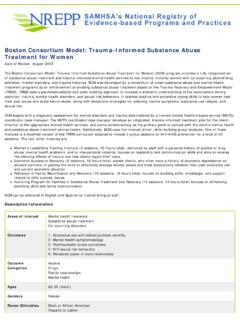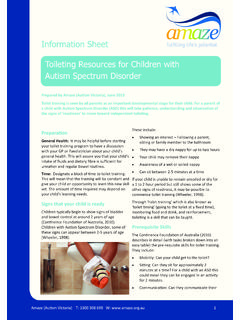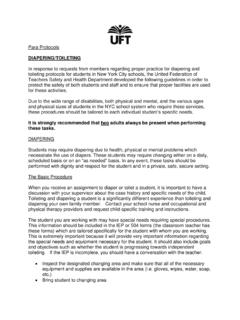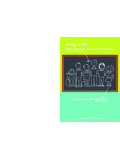Transcription of Session 2 Brain Development; Ages and Stages; Comfort …
1 _____ _____ Copyright 2011 Family development Resources, Inc. 1-800-688-5822 7 Session 2 Brain development ; ages and Stages; Comfort and Calming Nature vs. Nurture The debate of whether children are more influenced by their genetics (nature) or the way they are parented (nurture) is over. From nearly the dawn of modern civilization, anyone and everyone who felt so inclined would engage in the nature vs. nurture argument. Just in case you missed it, the argument would focus on whether children develop good or bad characters because they were born that way (nature) or because they were treated that way (nurture, or in the case of a bad character, the lack of it!)
2 Well, after hundreds of thousands of debates over the centuries, professionals on both sides have finally reached a conclusion: we are who we are as a result of a relationship between nature and nurture. In essence, it s not a contest, but a dance. Everyone comes into the world with a genetic makeup, or nature. It s theirs and theirs alone. Height, skin color, hair color, gender and other physical features are the obvious. Temperament, sexual preference, predisposition to alcoholism, to cancer, and to other illnesses are some of the not so obvious that are also a part of us. They re the gifts our parents give us at conception, and try as we may, there s not much you can do to not be who you are genetically determined to be.
3 But the environment or nurture can influence these predispositions and how, or if, they ll play out. _____ _____ Copyright 2011 Family development Resources, Inc. 1-800-688-5822 8 children s Brain development children s brains are a work in progress. How they develop is related to the experiences they have in their early years. How children s brains develop depends upon how the genes they re born with (nature) interact with the experiences they have (nurture). Parts of the Brain The Brain is made up of five major parts: 1. Brainstem The brainstem is fully developed at birth. The brainstem is responsible for survival functions such as blood pressure, heart rate, and body temperature.
4 The brainstem must be fully functional at birth in order for an infant to survive. 2. Cerebellum The cerebellum controls a person s automatic movements and balance. Dancing, kicking a football, or bringing a cup to the lips to drink are all coordinated by the cerebellum. If a child s cerebellum is damaged, the Brain cannot coordinate movement. 3. Midbrain The midbrain controls sleep, arousal responses, appetite and motor movements such as running and skipping. The midbrain is very important for moving. 4. Limbic System The limbic system controls emotions and long-term memories. The limbic system can override rational thoughts and parts of the Brain controlled by the brainstem such as blood pressure.
5 Stress will cause blood pressure to go up. A part of the limbic system is involved in attaching emotions to memory. So, every time we remember an event, the emotion comes along with it. Another part of the limbic system converts information from learning and working into long-term memory. It checks new information against stored experiences in order to establish meaning. 5. Cortex The cortex is the executive branch of the Brain . It regulates decision-making and makes judgments about incoming information. Different regions of the cortex are responsible for processing our vision, touch, hearing, speech, language development , and problem solving. It also allows us to plan and rehearse our future actions.
6 How children s Brains Develop Each child is born with 23 billion neurons. These 23 billion neurons form trillions of synapses connections). At birth, the connections are not very fast. But, the more the Brain is stimulated, the faster and stronger these connections becomes. These connections then become a part of the permanent structure of the Brain . But, if the Brain is not stimulated, the pathways dry up. In the past, neuroscientists assumed that by the time babies are born, the structure of their brains had been genetically determined. Today, scientists know that the Brain of the baby is still forming connections responsible for feeling, learning, and remembering after birth.
7 At birth, the Brain s 100 billion or so neurons form more than 50 trillion synapses (connections). Most of the synapses that are crucial to learning form after birth. Genes have already determined the Brain s basic wiring, and have formed the connections in the Brain stem that will make the heart beat and lungs respire. _____ _____ Copyright 2011 Family development Resources, Inc. 1-800-688-5822 9 In the first months of life, the number of synapses will increase to more than 1,000 trillion. It is through the development of these synapses that the Brain develops a functional architecture. Without this, there would be no habits, no thoughts, no consciousness, no memories, and no mind.
8 Experiences from the outside world create the architecture of the Brain , allowing the Brain to create or modify existing connections. Effects of Violence and Stress on Kids Brains Neuroscientists are now recognizing Brain damage caused by abusive experiences. Abusive experiences can increase the risk of developing behaviors ranging from: Aggression Failure Language deficits Depression Mental disorders Diabetes Asthma Epilepsy High blood pressure Immune system dysfunction Abusive experiences organize the millions of constantly active connections between Brain cells into atypical networks. Bad experiences affect the Brain primarily through stress hormones such as cortisol and adrenaline.
9 These stress hormones are designed to respond to psychological or physical danger and prepare the body for fight or flight. Normally, the transition is smooth and the Brain and body go back to an even keel when the danger is over. When these hormones are overactive as a result of persistent stresses, they can take over genetic regulation. The terrorized genes set up irregular networks of connections between Brain cells. Some examples are an epileptic seizure instead of a clear signal, a depressive episode instead of a happy thought, or a surge of rage instead of a willingness to compromise. What Every Child Needs To promote children 's Brain development , every child needs: Interaction.
10 Consistent, long term attention from caring adults increases children 's capacity to learn. Touch. Holding and cuddling children help their Brain grow. Stable Relationships. Relationships with parents and other caregivers buffer stress that can harm your child. Safe, Healthy Environments. Environments should be free of lead, loud noises, sharp objects and other dangers. Self-Esteem. Self-esteem grows with respect, encouragement and positive role models from the beginning. Quality Care. Quality care from trained professionals can make the difference when you can t be with your child. Play. Play helps children explore their senses and discover how the world works. _____ _____ Copyright 2011 Family development Resources, Inc.







